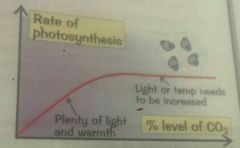![]()
![]()
![]()
Use LEFT and RIGHT arrow keys to navigate between flashcards;
Use UP and DOWN arrow keys to flip the card;
H to show hint;
A reads text to speech;
22 Cards in this Set
- Front
- Back
|
What do animal cells contain? |
Nucleus, cytoplasm, cell membranes, mitochondria and ribosomes |
|
|
What do plant cells contain? |
Nucleus, cytoplasm, cell membrane, mitochondria, ribosomes, cell wall, permanent vacuole, and chloroplasts |
|
|
Define diffusion |
Diffusion is the spreading out of particles from an area of high concentration to an area of low concentration |
|
|
What are examples of specialised cells? |
Palisade lead cells, guard cells, red blood cells, and sperm and eggs. |
|
|
What are palisade leaf cells? |
They are packed with chloroplasts for photosynthesis. They are crammed at the top for more light access. Their tall shape gives them a large surface area for absorbing CO2. |
|
|
What are guard cells? |
When the plant has lots of water the guard cells fill with it and go plump and turgid. This makes the stomata open so gases can be exchanged for photosynthesis. When the plant is short of water, the guard cells lose water and become flaccid, making the stomata close. This helps stop too much water vapour escaping. |
|
|
What are red blood cells? |
They have concave shapes for a big surface area for absorbing oxygen. They are packed with haemoglobin, which absorb oxygen. They have no nucleus to leave more room for haemoglobin. |
|
|
What are sperm and egg cells? |
They are specialised for reproduction |
|
|
What are leaves made of ? |
Mesophyll tissue, xylem and phloem, and epidermal tissue. |
|
|
What is a mesophyll tissue? |
Where most of the photosynthesis of a plant occurs. |
|
|
What are xylem and phloem? |
They transport things like water, mineral ions and sucrose around the plant. |
|
|
What is an epidermal tissue? |
This covers the whole plant. |
|
|
What is the equation for photosynthesis? |
Carbon dioxide + water -----> glucose + oxygen . This uses sunlight and chlorophyll. |
|
|
What is photosynthesis? |
Photosynthesis is the process that produces food in plants and algae. The food is produces is glucose. |
|
|
What are the limiting factors to photosynthesis? |
Light, temperature, and CO2. |
|
|
How is light a limiting factor |

|
|
|
How is carbon dioxide a limiting factor? |

|
|
|
How is temperature a limiting factor? |

|
|
|
How do plants use glucose? |
For : respiration, making cell walls, making proteins, stored in seeds and stored as starch. |
|
|
Define habitat |
A place where an organism lives |
|
|
What environmental factors affect where an organism lives? |
» temperature » availability of water » availability of oxygen and carbon dioxide » availability of nutrients » amount of light |
|
|
Define catalyst |
A substance which increases the speed of a reaction, without being changed or used up in the reaction. |

